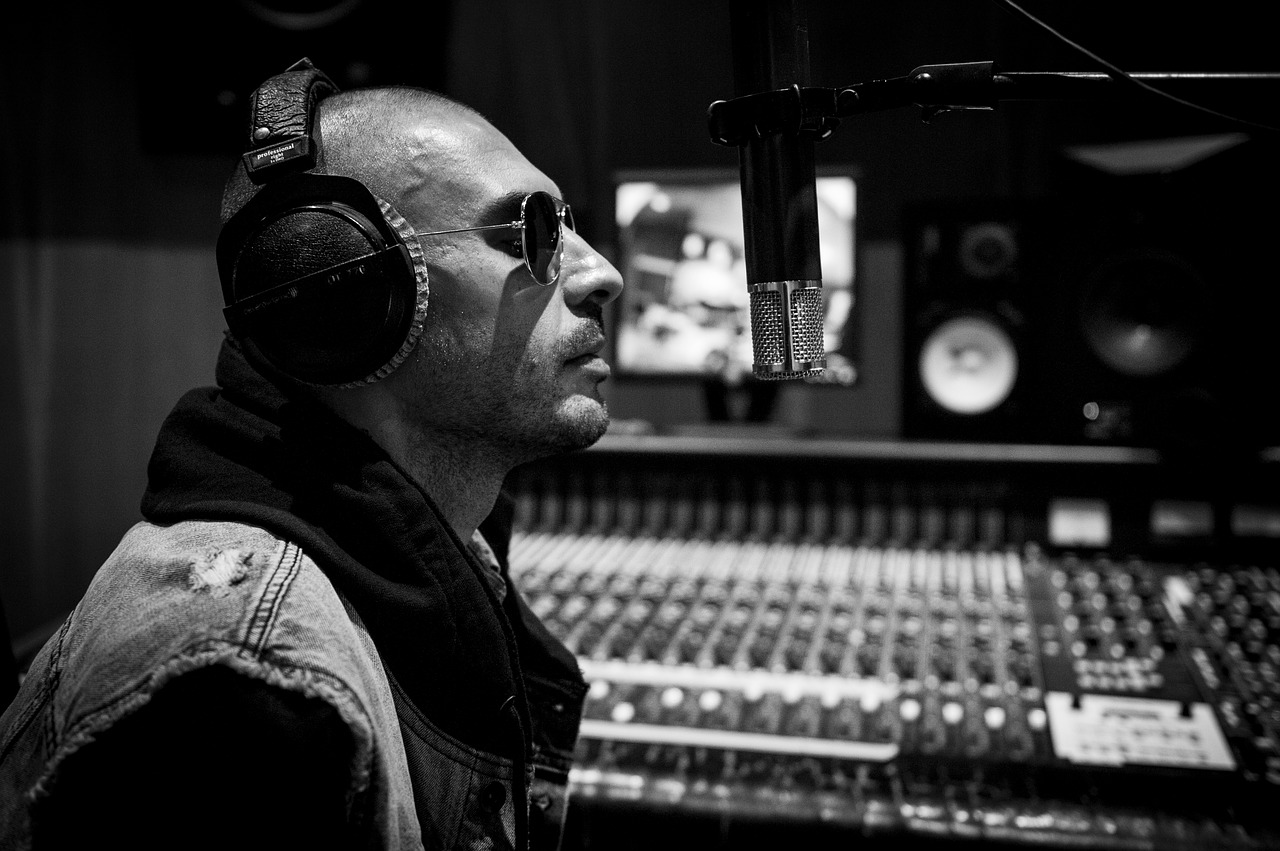
7 Best Microphones For Teachers
March 21, 2022
How To Plan a Guitar Practice Routine
March 24, 2022
Whether you’re a bedroom music producer or an online streamer, finding a perfectly noise-free recording environment is hard.
Instead of moving your studio somewhere else, a simpler option is finding the best mics for Noisy Environments!
Our Recommendations for Best Mics for Noisy Environments
- Shure SM57 (Best Overall Microphone for Noisey Environments)
- Audio-Technica ATR-2100 (Most Versatile Microphone for Noisey Environments)
- Sennheiser MD-421 II (Best Preimuim Microphone for Noisey Environments)
- Rode PodMic (Best Podcast Mic with Noisey Environments)
1. Shure SM57

Pros:
- Cardioid pickup pattern cancels out background noise
- Clean and full sound while maintaining focus on the main input source.
- Has been used since the 60s’
Cons:
- No Pop-shield for vocals
- Requires pre-amp or audio interface to set gain
The Shure SM57 is a great choice for a noisy environment because of its staple status as a workhorse studio microphone. It was originally released in 1965 and since then has been used for everything from professional studio recordings to bedroom producers.
While it was originally designed for instrument recordings its ability to record vocals is no joke if you’re looking to reduce background noise on your microphone.
It uses an advanced cardioid pickup pattern that helps to isolate the main sound source picked up by the mic while canceling out any background noise that may be happening in the studio around you.
2. Audio-Technica ATR-2100

Pros:
- Designed specifically for your voice
- Built-in headphone jack for monitoring
- Versatile connections
Cons:
- Classic microphone design might not suit everyone
- Onboard controls are small and flimsy
- Some issues with USB recording on Windows computers
Audio Technica’s ATR-2100 is one of the best microphones to get if you’re trying to reduce background noise. It was built with a vocal focus in mind for applications such as podcasting and streaming where vocal clarity is essential.
The ATR-2100 achieves its noise-canceling capabilities through a combination of its low-mass diaphragm that gives the mic an extended frequency response, and its cardioid polar pattern that filters out sounds happening around the mic.
This microphone is also very versatile with the choice to record either via the analog XLR port or the USB-C connection that records directly into your computer.
3. Sennheiser MD-421 II

Pros:
- Very high build and tech quality
- 5 bass roll-off positions
- Advanced noise-canceling features
Cons:
- Quite pricey
- XLR connection only
The most expensive microphone on this list… but for good reason. The Sennheiser MD-421 offers a great range of features that make the mic perfect for recording in a noisy environment. This microphone produces super crisp recordings and can be customized to suit your environment.
The MD-421 II features a five-position bass roll-off switch. This allows you to fine-tune how sensitive you want this microphone’s noise cancellation to be. There are 2 main modes of bass roll-off, Music and Voice mode, but with 3 more increments in between, you can find the perfect spot for your noisy environment.
The full-bodied cardioid pattern and feedback rejection also help make your recordings clear and free of background noise. The mic uses a cardioid magnet field to pick up on such interruptions and prevent them from interfering with the rest of the sound source.
So while the mic is more expensive it brings a level of technological advantage not seen in more affordable mics.
4. Rode PodMic

Pros:
- Designed to reduce background noise
- Internal pop filter
- Sounds great on vocal work
Cons:
- Might needs external gain
- No stand or cables included
- Need to be close to mic for noise cancellation to work
When Rode set out to make a mic specifically for podcasting, reducing ambient noise was an important feature to get right. Luckily it paid off and the Rode PodMic is one of the best mics if you don’t want to pick up any background noise.
The philosophy of this microphone was that sometimes podcasts have to be recorded in noisy environments such as cafes or outdoors. With that in mind, the microphone has been designed with a tight cardioid polar pattern that keeps the focus all on you.
While it performs its job well for recording podcasts it might not be the best choice if you want versatility out of your mic. I wouldn’t recommend using it to try recording amps of guitars for example. If your looking to cut out background noise with a vocal mic then this is a great choice.
FAQ:
How Do I Stop My Mic from Picking Up Background Noise?
Stopping your mic from picking up background noise comes down to a range of factors. The most important ones are your environment, type of microphone and signal chain/mic settings.
Making sure you’re in a suitable environment is the most important thing you can do to reduce background noise. Recording in a quiet environment is the most straight forward solution to reducing background noise but also the hardest to achieve. We can’t all have sound proof studios to record in!
The type of microphone you use also help to stop background noise from getting picked up. You’ll pick up less background noise using a dynamic mic than you with a condenser mic.
If your environment and microphone aren’t the problem then the most efficient way to reduce background noise on your mic is to change your signal chain and mic settings. Using software filters in programs such as OBS to set your mic up correctly can do wonders for reducing background noise.
Another great way to try and eliminate background noise is using an isolation shield. Isolation shields deflect unwanted sounds from around your microphone. This means that sounds coming from the sides and from behind your microphone are less likely to interfere with your recording.
Is There A Microphone That Cancels Out Background Noise?
Unfortunately, there is no microphone that can completely eliminate background noise without any further tinkering. Some mics are better suited to noise cancelling in noisy environments but it will always come down to a number of different factors to make your microphone as resistant to background noise as possible.
Condenser vs Dynamic Microphone in a Noisey Environment
When picking a microphone you have two main options; a condenser mic or a dynamic mic. A general rule of thumb is that condenser mics are more sensitive and pick up more detail; while dynamic mics can withstand more noise making them great for live performance and instruments.
When it comes to noise cancellation a dynamic mic will get rid of more background noise than a condenser mic will. A decent quality dynamic mic will also sound warmer and less harsh than a condenser mic will.
Does an audio interface help reduce background noise?
An audio interface won’t directly help with reducing background noise in your recordings. I will however give you better control of your mic gain and signal chain. The more control you have over your sound the better you’ll get at filtering out background noise.
Using an audio interface also gives you the option of using condenser mics. Usually, condenser mics pick up more background noise but they also provide a more detailed sound. Condenser mics usually require phantom power for them to work and an audio interface will provide that power.
Should I Use a Pop Filter for Noise Cancelling
Unfortunately, a pop filter won’t help you reduce background noise. Pop filters are designed to reduce the impact of sounds close to the microphone. These sounds are usually caused by the air coming out of your mouth when pronouncing certain letters. These are called plosives. So while they assist with noise cancellation up close they won’t filter out the sound of the room you’re in.
What is Bass Roll-off?
Bass roll-off is a useful tool to use when trying to reduce background noise. The way it works is by filtering out (or rolling off) the low frequencies of your recording. This is especially useful if you are recording near a road or other source of loud noises as it reduces the ground hum these sounds create.
What Effects Help in a Noisey Environment?
Some signal chain effects can help reduce background noise on your microphone. Most notably is the use of compression. Introducing compression in between your mic and the recording device can be a quick way to boost the sound source you want to record without raising the overall volume.



